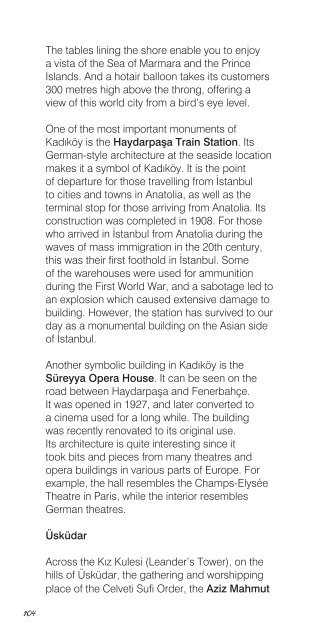istanbul - C2C
istanbul - C2C
istanbul - C2C
You also want an ePaper? Increase the reach of your titles
YUMPU automatically turns print PDFs into web optimized ePapers that Google loves.
52<br />
This important road of the Byzantine Period<br />
was not neglected during the Ottoman Period,<br />
and continued to be used. It only changed<br />
its identity, together with the rest of the town,<br />
and was renamed as Divanyolu which literally<br />
means the road to the court. The road took this<br />
name because the viziers attending to the Divan<br />
(Imperial Court) sessions at Topkapı Palace<br />
used that road on leaving the palace meetings.<br />
Despite the name changed its fate remained the<br />
same: rebels used the route to storm the palace,<br />
and many were executed along it. In short, the<br />
road has witnessed the history of İstanbul.<br />
The first square along the road was the<br />
Agusteion Square, today known as Sultanahmet<br />
Square. During the Roman Period, and its<br />
continuation, the Byzantine Period, the squares<br />
or forums were surrounded by various buildings.<br />
Augusteion Square was surrounded by the<br />
Great Palace, the Hippodrome and Ayasofya,<br />
the most important monuments of the past to<br />
have survived to our day. The Million Stone was<br />
regarded as the starting point of all destinations<br />
when İstanbul was considered to be the centre of<br />
the world. Although it is an unassuming broken<br />
column near the Yerebatan Cistern that fails to<br />
attract the attention of passersby at present,<br />
it was the starting point of all roads in the<br />
Byzantine Period.<br />
The road called Mese in Byzantine Period and<br />
Divanyolu in Ottoman Period was approximately<br />
on the same route with today’s tram line. By<br />
following the tram line the other squares can<br />
be reached. As this route played an interesting<br />
role in the Ottoman Period, to follow its course<br />
enables visitors to see some important Ottoman<br />
buildings. The first building is the Firuz Agha<br />
Mosque, which is located to the left of the road.



